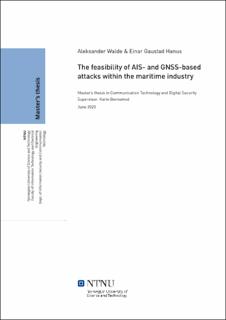| dc.description.abstract | Den maritime skipsfartsindustrien gjennomgår en digitaliseringsprosess som har betydelig innvirkning på drift og eksisterende forretningsmodeller. Dette har resultert i en bransje som blir stadig mer avhengig av digitale systemer for å optimalisere effektiviteten. Når ny teknologi fører industrien fremover og skaper nye muligheter, dukker det imidlertid opp nye cybertrusler.
I dag er Automatic Identification System (AIS) og Global Navigation Satellite System (GNSS) to kjerneteknologier som brukes til å øke navigasjons- og situasjonsbevissthet. Systemene har bidratt til å øke den generelle sikkerheten innad i den maritime industrien. Til tross for dette er det tydelige svakheter i systemene, da verken krypterings- eller autentiseringsmekanismer er til stede. Dette resulterer i at de fleste brukere av GNSS og AIS er sårbare for angrep. Ettersom open-source programvare blir stadig mer utbredt, reduseres kompleksiteten og kostnadene for å utnytte sårbarhetene innen AIS og GNSS jevnlig. Dette resulterer i at de fleste brukere av AIS og GNSS tjenester er mer utsatt enn noen gang.
Denne masteroppgaven presenterer nødvendig utstyr og prosessen som må gjennomføres for å utnytte de underliggende svakhetene i AIS og GNSS. Vi gjennomførte to eksperimenter, ett for hver av teknologiene. Eksperimentene bidro til å identifisere vanskelighetsgraden og innsatsen som er nødvendig for å initiere i gang AIS- og GNSS-baserte angrep. Videre estimerte vi kostnadene forbundet med å sette i gang slike angrep ved å bruke en modell kjent som ”the Resource Cost Estimate Model”, som er en modell basert på ”the Intrusion Kill Chain”. Modellen bidro til å ytterligere identifisere trinnene AIS- og GNSS-baserte angrep må gjennomgå og bidro til å bestemme de tilhørende kostnadene på hvert trinn i angrepet. Videre har vi gjennomført åtte intervjuer for å undersøke om dekksoffiserer, maritime piloter og sjøtrafikkledere er kjent med de underliggende svakhetene teknologiene har. Intervjuobjektene presenterte også mottiltak som er satt i verk for å redusere effekten av potensielle angrep. Vi oppdaget imidlertid at disse mottiltakene ikke er tilstrekkelige til å betydelig redusere dagens risiko. Til slutt gjennomførte vi en litteraturstudie som belyser teknikker som kan hindre AIS- og GNSS-baserte angrep. | |
| dc.description.abstract | The maritime shipping industry is experiencing a digital transformation that has a significant impact on operations and existing business models. It has resulted in an industry that is getting increasingly more dependent on digital systems to optimize its efficiency. However, as new technology pushes the industry forward and creates new opportunities, new cyber threats emerge.
Today, the Automatic Identification System (AIS) and Global Navigation Satellite Systems (GNSSs) are two core technologies used to increase navigational and situational awareness. The systems have assisted in increasing the overall safety within the maritime industry. However, apparent weaknesses are present within the systems as neither encryption nor authentication mechanisms are enabled by default. This leaves most GNSS and AIS users vulnerable to attacks. As open-source software becomes increasingly more prevalent, the complexity and cost to exploit the vulnerabilities within AIS and GNSS are steadily reduced. Consequently, leaving most users of AIS and GNSS services more vulnerable than ever.
This master thesis presents the necessary equipment and the process that needs to be conducted to exploit the underlying weaknesses within AIS and GNSS. We conducted two experiments, one for each of the two technologies. The experiments helped identify the simplicity and effort needed to initiate AIS- and GNSS-based attacks. Moreover, we determined the costs associated with initiating such attacks by using the
Resource Cost Estimate Model, which is a model based on the Intrusion kill Chain. The model assisted in further identifying the steps AIS- and GNSS-based attacks need to undergo and helped determine the associated cost at each step of the attack. Furthermore, we conducted eight interviews to investigate whether deck officers, maritime pilots, and maritime traffic leaders are aware of the underlying weaknesses within the technologies. The interviewees also outlined the current countermeasures that are set in place to reduce the impact of potential attacks. However, we discovered that these countermeasures are not adequate in sufficiently mitigating today’s risks. Lastly, we conducted a literature study that sheds light on techniques that can thwart AIS- and GNSS-based attacks. | |
